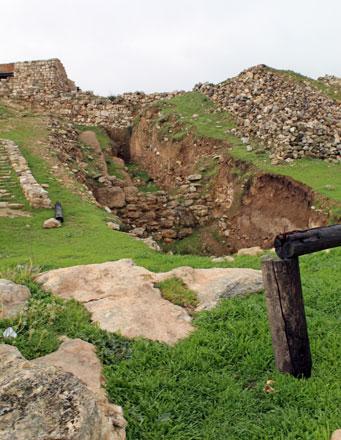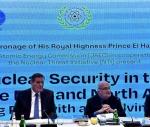You are here
US expert sheds light on collapse and resilience of Levant communities
By Saeb Rawashdeh - Jun 04,2019 - Last updated at Jun 04,2019

Tell Umayri outside of Amman with what is left on the site's surface, winter 2019 (Photo courtesy of Amy Karoll)
AMMAN — The system of centralised, urbanised settlements established in agriculturally productive valleys and plans broke down in the southern Levant around 2,500-1,950 BC, during the Early Bronze (EB) Age IV, noted an American archaeologist.
“Previous theories imply that this breakdown coincided with a major climatological event: a widespread drought that occurred around 2,200 BC across the ancient Near East. According to this theory, a series of crises in the Near East occurred over a century, first affecting semi-arid regions along agricultural margins in northern Mesopotamia and moved towards the eastern margins of the Levant,” explained Amy Karoll, adding that settlements along river systems were less affected due to access to water that was not dependent on rainfall.
Since this environmentally deterministic theory was first proposed, she continued, a new data has called into question the timing of the EB IV decline. As such, “collapse” may no longer be a valid model to analyse this period, Karoll said, and, instead, she proposed investigating “alternative explanations that situate people as active agents in a resilient socioeconomic system”.
“The changes in economic and political systems were conscious choices, shaped and limited by outside factors,” the scholar underlined, noting that rather than a sudden collapse of society due to catastrophic climatic change, disrupting agricultural production, it appears that the EB IV transition was the logical consequence of people actively responding to their steadily changing environment.
Karoll, who is a PhD candidate at the University of California Los Angeles in Near Eastern Languages and Cultures, has studied sites of the Jordan Valley.
According to her, the main site is Khirbet Iskander, located on the central Transjordanian Plateau, some 24km south of Madaba and right off the King’s Highway.
“The EB IV occupation is particularly important at the site: Khirbet Iskander was a fortified, sedentary town during the EB IV, one of very few. Another is Bab edh-Dhra, located near the Dead Sea on the Karak Plateau,” she noted, adding that she also looked at Tell Al Hammam and Tell Iktanu in the Jordan Valley, Khirbet Al Batrawy, northeast of Amman, and Tell Al Umayri on the road to the airport.
Trade connections between sites in east and west banks had been well known as Tell Al Hammam on the eastern side and Jericho on the western side had very close trade connections during the EB IV, Karoll claimed.
“Previous ideas of a purely nomadic society, first proposed in the mid-20th century, have been shown to be a fallacy,” the researcher said. She pointed out that agriculture is either integrated into seasonal rounds of pastoral groups or trade is required to provide these goods.
Furthermore, societies incorporated both modes of economy, Karoll said, adding that her study will not address urban agriculturalists and pastoral nomads as a dichotomy, but rather attempt to situate these concepts along a spectrum, where each is reliant upon the other.
Variations within pastoral systems, especially as they change over time during the late third millennium BC, will be addressed in order to identify the impact pastoral nomads had on economic, social and political regimes of this period, she stressed.
Her future plans regarding a dissertation research is to use this research as a means to study collapse and resilience in the entirety of the southern Levant.
“The EB IV is not the only period of ‘collapse’ and change in the Levant. These changes occur at every major period transition, from the Middle to the Late Bronze Age, from the Late Bronze Age to the Iron Age, etc,” Karoll underscored.
Related Articles
AMMAN — The Early Bronze IV (c. 2,500- 2,000BC) in the ancient Near East was marked by a systematic change.
AMMAN — Bayesian modelling, a method of statistical analysis, applied to Radiocarbon dating, has changed perceptions of the Early Bronze Age
AMMAN — The significance of demographic study originates from the fact that it highlights social and cultural aspects of a society, accordin


















